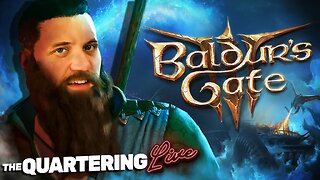Premium Only Content

Krampus is a horned, anthropomorphic figure in the Central and Eastern Alpine folklore of
Krampus is a horned, anthropomorphic figure in the Central and Eastern Alpine folklore of Europe who, during the Advent season, scares children who have misbehaved. Assisting Saint Nicholas, or Santa Claus, the pair visit children on the night of 6 December, with Saint Nicholas rewarding the well-behaved children with gifts such as oranges, dried fruit, walnuts and chocolate, while the badly behaved ones only receive punishment from Krampus with birch rods. Krampus day itself, on the other hand, is on the 5th of December.
The origin of the figure is unclear; some folklorists and anthropologists have postulated it as having pre-Christian origins. In traditional parades and in such events as the Krampuslauf (English: Krampus run), young men dressed as Krampus attempt to scare the audience with their antics. Such events occur annually in most Alpine towns. Krampus is featured on holiday greeting cards called Krampuskarten.
The figure has been imported into American popular culture, and has appeared in movies, TV and video games.
ETYMOLOGY
Krampus is thought to come from either Bavarian: krampn, meaning "dead", "rotten", or from the German: kramp/krampen, meaning "claw".
ORIGINS
The history of the Krampus figure has been theorized as stretching back to pre-Christian Alpine traditions, with celebrations involving Krampus dating back to the 6th or 7th century CE. Though there are no written sources before the end of the 16th century.
Discussing his observations in 1975 while in Irdning, a small town in Styria, anthropologist John J. Honigmann wrote that:
The Saint Nicholas festival we are describing incorporates cultural elements widely distributed in Europe, in some cases going back to pre-Christian times. Nicholas himself became popular in Germany around the eleventh century. The feast dedicated to this patron of children is only one winter occasion in which children are the objects of special attention, others being Martinmas, the Feast of the Holy Innocents, and New Year's Day. Masked devils acting boisterously and making nuisances of themselves are known in Germany since at least the sixteenth century while animal masked devils combining dreadful-comic (schauriglustig) antics appeared in Medieval church plays. A large literature, much of it by European folklorists, bears on these subjects. ... Austrians in the community we studied are quite aware of "heathen" elements being blended with Christian elements in the Saint Nicholas customs and in other traditional winter ceremonies. They believe Krampus derives from a pagan supernatural who was assimilated to the Christian devil.
The Krampus figures persisted, and by the 17th century Krampus had been incorporated into Christian winter celebrations by pairing Krampus with St. Nicholas.
LINK TO ARTICLE: http://en.wikipedia.org/wiki/Krampus
TAGS: Krampus, Devils, Ritual masks, Masks in Europe, Bavarian folklore, Christmas in Germany, Supernatural legends, Mythological monsters, Santa's helpers, European folklore characters, European demons, Holiday characters, Christmas characters, German legendary creatures, German legends, German folklore, Austrian folklore, Alpine folklore
#GeneralKnowledge #AudibleWikiFactory #Audible #Wikipedia #Krampus
-
 34:34
34:34
The Audible Wiki Factory
2 years agoSaint Patrick's Day, or the Feast of Saint Patrick, is a religious and cultural holiday held on
801 -
 LIVE
LIVE
Man in America
12 hours agoInflation, Debt & War: The 2032 Crash Cycle Is Here—Nations Will FALL w/ Martin Armstrong
847 watching -
 LIVE
LIVE
Adam Does Movies
11 hours agoTalking Movies + Ask Me Anything - LIVE
145 watching -
 2:55:43
2:55:43
TimcastIRL
3 hours agoTrump DOJ To Ban Trans People From Owning Guns After Catholic School Shooting | Timcast IRL
133K82 -
 LIVE
LIVE
The Quartering
2 hours agoBaldur's Gate 3 First Playthrough!
728 watching -
 LIVE
LIVE
Rallied
5 hours ago $3.62 earnedWarzone Solo Challenges
354 watching -
 57:40
57:40
MattMorseTV
4 hours ago $6.35 earned🔴Trump just SHATTERED the RECORD.🔴
29.3K70 -
 43:39
43:39
WickedVirtue
1 hour agoLate Night Spooky Plays
5.25K -
 2:04:02
2:04:02
Glenn Greenwald
5 hours agoTrump and Rubio Apply Panama Regime Change Playbook to Venezuela; Michael Tracey is Kicked-Out of Epstein Press Conference; RFK Senate Hearing | SYSTEM UPDATE #508
80.8K94 -
 58:36
58:36
Total Horse Channel
7 hours ago2025 CSI3* A Coruña Porsche - Grand Prix
10.9K